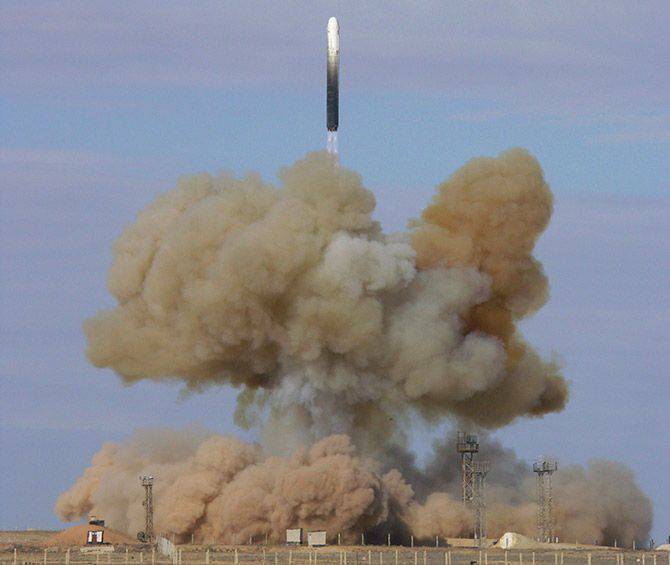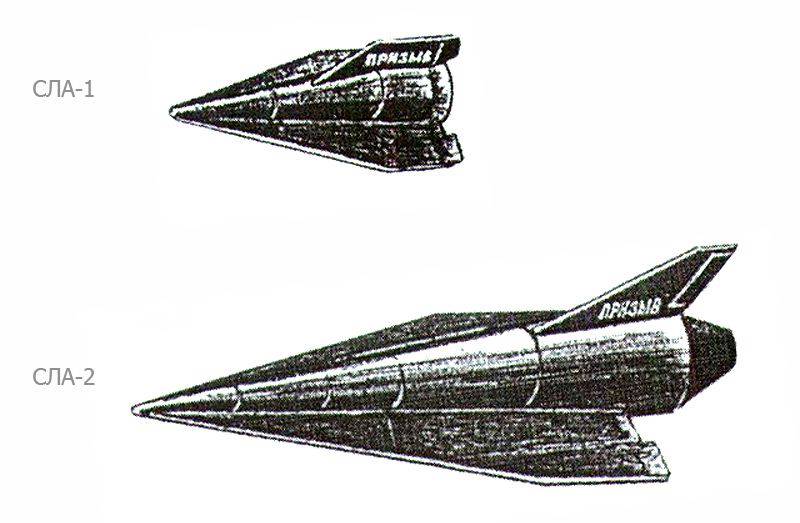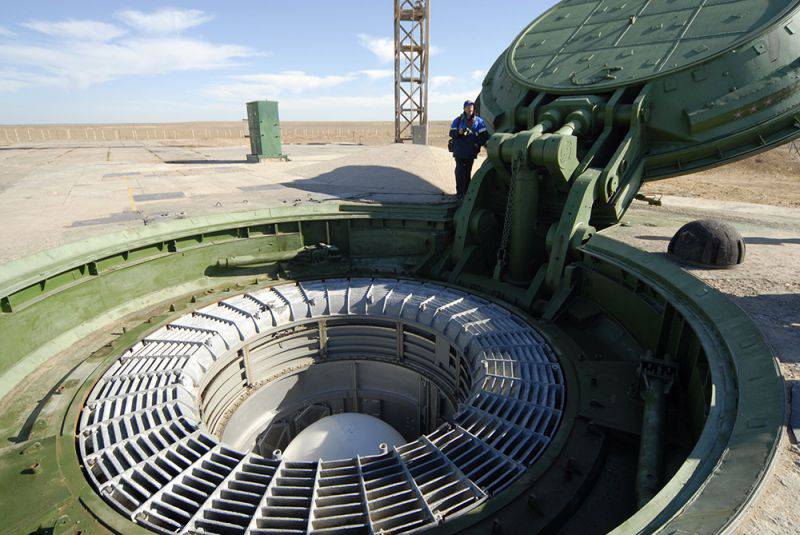Rocket complex "Albatross"
The development in the Soviet Union of a new missile system, with the ability to overcome a layered missile defense system, was to become our asymmetric response to the creation of a missile defense system in the United States as part of the PIO program. The new complex was to receive maneuvering, planning (winged) combat units with hypersonic speed. These units should have been able to maneuver up to 1000 kilometers in azimuth when entering the atmosphere on the Karman line at speeds around 5,8-7,5 km / s or Mach 17-22. At the core of the entire Albatross project were proposals for a guided combat unit (UBB), which was able to perform an evasion maneuver maneuver. UBB had to fix the launch of the enemy’s antimissile and implement a programmed evasion maneuver. Elaboration of such UBBs began as early as 1979-1980, in the USSR, work was carried out on designing an automation system for the execution of such an anti-missile maneuver.
The new rocket was supposed to be a three-stage, it was planned to equip it with a cruise block with a nuclear charge, which was able to approach the target at a small height and maneuver near it. Most of the elements of the rocket itself and the installations for its launch were planned to be equipped with serious laser protection weapons and nuclear explosions, to ensure the maximum likelihood of striking an enemy at any level of opposition from his side. The control and guidance system of the Albatross ICBM was autonomous inertial.
As noted above, the project developer was appointed G. A. Efremov. At the same time, the Soviet government attached particular state importance to the project, since at that time it was a serious problem to overcome the missile defense, which was worked out in the United States. Against this background, it seems surprising that the creation of a new strategic complex was entrusted to an enterprise that had never before worked with mobile missile systems and solid-propellant missiles. The creation of a winged combat unit in general was completely new.
Initially, the Soviet designers were looking for the possibility of creating a combat unit that could evade antimissiles, it was from this idea that the Albatross missile development project was born. The combat unit of this ICBM not only carried a nuclear charge, but also had to detect the launch of the enemy’s antimissile in time and activate its own evasion complex. At the same time, the maneuvers had to be very diverse, which was to ensure sufficient unpredictability of the trajectory of movement. A distinctive feature of the new intercontinental rocket was to be that its course was formed at altitudes that did not exceed 300 km. At the same time, it was quite possible to fix the launch, but it was impossible to accurately predict the trajectory and pave the adequate way to counter the missile warheads. The missile was to be equipped with one or several (no exact information) planning cruise units (PCB) with nuclear charges. By inertia, the PKB made a controlled flight in the atmosphere (planning) and was able to reach the object of attack in a large range of heights and from any direction.
By the end of 1987, the draft design of the Albatross ICBM was ready, but it drew criticism from the country's defense ministry. The design of the complex continued until the beginning of 1989. The main reason for the cessation of development on this topic was the doubt in the timing of this project, including due to the problems that accompanied the technical solutions incorporated in the project. Also, the collapse of the USSR negatively affected the project.

In June, at the meeting held at the NPO Mashinostroenie, the general director of the NGO G. A. Efremov put forward a proposal to turn the Albatross complex into a universal complex for the Strategic Missile Forces of the country - for mobile and mine-based types. However, this proposal has caused strong opposition from other developers of ICBMs in the country - the Moscow Institute of Heat Engineering (MIT) and the Yuzhnoye Design Bureau from Dnepropetrovsk. And already in September 1989, in addition to the Resolution of the Council of Ministers of the USSR on February 9, a new solution was issued, which ordered the creation of two new missile systems, the stationary mine and mobile ground rockets based on the three-stage solid-fuel rocket created by MIT, universal for both complexes. for a mobile soil complex "Topol-9". This research topic was “Universal” (RT-1987PM2 / 2Ж2 rocket, later - Topol-M). The complex based in the mine launcher was created at Yuzhnoye Design Bureau, and MIT was engaged in the development of a mobile soil rocket complex. The active development of the Albatross complex in the interests of the Strategic Missile Forces of the Soviet Union was stopped after the conclusion of the START-8 agreement in 65, however, testing of the UBB prototypes did continue. According to another, unconfirmed official information, work on the Albatross complex was stopped even after the preliminary design was reviewed by representatives of the Ministry of Defense in approximately 1991-1.
Anyway, with high probability we can say that the flight tests of the UBB prototypes of this complex were carried out in 1990-1992 years. The launches were carried out from the Kapustin Yar test site using the K65М-Р booster. The first launch was carried out 28 February 1990, "without separation" of the combat load. Later, with the use of developments on the Albatross complex, the NPO Mashinostroeniya began work on the creation of aeroballistic hypersonic combat equipment (AGGB) 4202 project.
Partly, the Albatross ICBM, together with hypersonic units for it, fell victim to the general decline of the country's military-industrial complex at the beginning of the 1990s, which occurred against the background of the collapse of the USSR. But, at the end of the 1990-s with the use of the existing groundwork for this project, work began, which eventually led to the appearance of the Topol-M and hypersonic units for its more advanced modification of the Yars, as well as for other ballistic missiles related to the new generation - "Bulava" and "Sarmat".

Work on the maneuvering combat units of the Albatross complex was attempted to be used exclusively for peaceful purposes. So, together with the specialists of TsNIIMASH, the engineers of the NPO Mechanical Engineering suggested creating an ambulance rocket-space complex called Priyv on the basis of the UR-100NUTTB ICBM. The complex, which was to be created by the 2000-2003 years, was planned to be used to provide emergency emergency assistance to ships of the sea, which were in distress in the waters of the world's oceans. As a payload for this ICBM, it was planned to mount special aerospace rescue aircraft, ALS-1 and ALS-2. Thanks to the use of these devices, the speed of delivering an emergency kit to a ship in distress could be from 15 minutes to 1,5 hours, and the landing accuracy is ± 20-30 meters. The weight of the cargo, depending on the type of ALS, was 420 and 2500 kg, respectively.
So, the SLA-1 rescue aircraft was able to deliver up to 90 life rafts or an emergency kit. And the SLA-2 rescue aircraft could deliver rescue equipment for marine vessels (sump module, fire module, diving module). In another variant - Robot-rescuer or remotely piloted aircraft.
Information sources:
http://militaryrussia.ru/blog/topic-844.html
http://nevskii-bastion.ru/albatross-rk
http://www.arms.ru/stati/raketno-kosmicheskaja-oborona/proekt-albatros.htm

Information